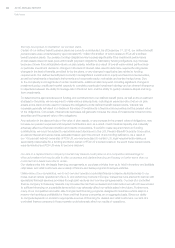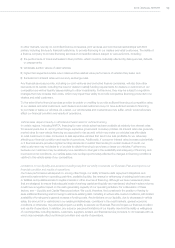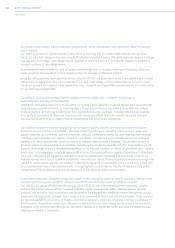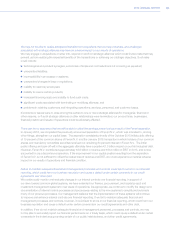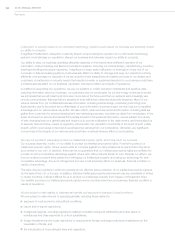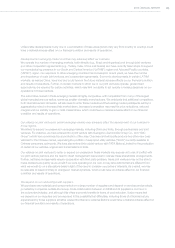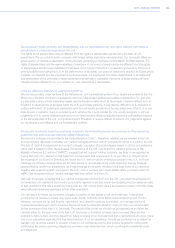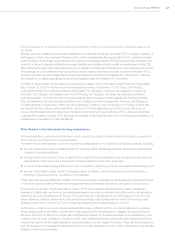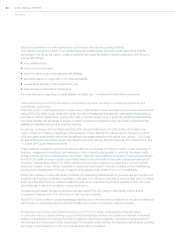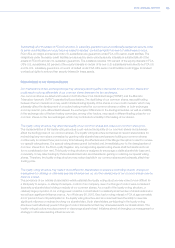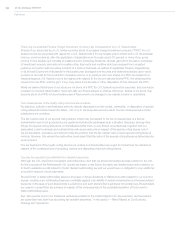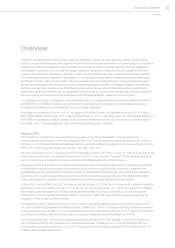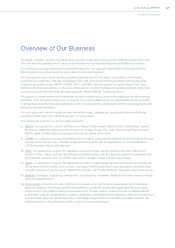Chrysler 2015 Annual Report Download - page 27
Download and view the complete annual report
Please find page 27 of the 2015 Chrysler annual report below. You can navigate through the pages in the report by either clicking on the pages listed below, or by using the keyword search tool below to find specific information within the annual report.
2015 | ANNUAL REPORT 27
If we are deemed to not maintain a permanent establishment in Italy, we could experience a material increase in our
tax liability.
Whether we have maintained a permanent establishment in Italy after the Merger (an “Italian P.E.”) is largely a question of
fact based on all the circumstances. We believe that, on the understanding that we should be a U.K.-resident company
under the Italy-U.K. tax treaty, we are likely to be treated as maintaining an Italian P.E. because we have maintained and
intend to continue to maintain sufficient employees, facilities and activities in Italy to qualify as maintaining an Italian P.E.
Should this be the case (i) the embedded gains on our assets connected with the Italian P.E. cannot be taxed as a result
of the Merger; (ii) our tax-deferred reserves cannot be taxed, inasmuch as they have been recorded in the Italian P.E.’s
financial accounts; and (iii) the Italian fiscal unit that was headed by Fiat before the Merger (the “Fiscal Unit”), continues
with respect to our Italian subsidiaries whose shareholdings are part of the Italian P.E.’s net worth.
FCA filed a ruling request with the Italian tax authorities in respect of the continuation of the Fiscal Unit via the Italian
P.E. on April 16, 2014. The Italian tax authorities issued the ruling on December 10, 2014 (the “2014 Ruling”),
confirming that the Fiscal Unit may continue via the Italian P.E. Moreover, in another ruling issued on October 9,
2015 (the “2015 Ruling”, and together with the 2014 Ruling, the “Rulings”), the Italian tax authorities confirmed
that the separation of Ferrari from the Group (including the first demerger of certain assets held through the Italian
P.E.) will qualify as a tax-free, neutral transaction from an Italian income tax perspective. However, the Rulings are
not assessments of certain sets of facts and circumstances. Therefore, even though the 2014 Ruling confirms that
the Fiscal Unit may continue via the Italian P.E. and the 2015 Ruling assumes such a P.E. to exist, this does not
rule out that the Italian tax authorities may in the future verify whether FCA actually has a P.E. in Italy and potentially
challenge the existence of such a P.E. Because the analysis is highly factual, there can be no assurance regarding our
maintenance of an Italian P.E. after the Merger.
Risks Related to Our Substantial Existing Indebtedness
We have significant outstanding indebtedness, which may limit our ability to obtain additional funding on competitive
terms and limit our financial and operating flexibility.
The extent of our indebtedness could have important consequences on our operations and financial results, including:
we may not be able to secure additional funds for working capital, capital expenditures, debt service requirements
or general corporate purposes;
we may need to use a portion of our projected future cash flow from operations to pay principal and interest on our
indebtedness, which may reduce the amount of funds available to us for other purposes;
we are more financially leveraged than some of our competitors, which may put us at a competitive disadvantage; and
we may not be able to adjust rapidly to changing market conditions, which may make us more vulnerable to a
downturn in general economic conditions or our business.
These risks may be exacerbated by volatility in the financial markets, particularly those resulting from perceived strains
on the finances and creditworthiness of several governments and financial institutions, particularly in the Eurozone.
Even though we are the 100 percent indirect owner of FCA US, it operates separately from a cash management
standpoint. Additionally, we have not provided guarantees or security or undertaken any other similar commitment in
relation to any financial obligation of FCA US, nor do we have any commitment to provide funding to FCA US in the
future. However, with the replacement of the prior FCA revolving credit facilities with the new FCA revolving credit
facilities entered into in June 2015, FCA no longer has limitations in providing funding to FCA US.
Furthermore, certain of our notes include covenants that may be affected by FCA US’s circumstances. In particular,
these notes include cross-default clauses which may accelerate the relevant issuer’s obligation to repay its notes in
the event that FCA US fails to pay certain debt obligations at maturity or is otherwise subject to an acceleration in the
maturity of any of those obligations. Therefore, these cross-default provisions could require early repayment of those
notes in the event FCA US’s debt obligations are accelerated or are not repaid at maturity. There can be no assurance
that the obligation to accelerate the repayment by FCA US of its debts will not arise or that it will be able to pay its debt
obligations when due at maturity.



